Wait But Why: The Story of Us – Summary of Part 1
Wait But Why, one of my favourite blogs on the internet, has released a series about society. It’s a tour of “U.S. history, world history, evolutionary psychology, political theory, and neuroscience”. The series is especially a timely piece right now. It gives us a framework through which we can reason about society. As of April 2020, there are 5 parts (10 chapters) in the series. Here, I will be summarising part 1.

We are Vessels for the Genes
Genes are a force of nature, their sole goal is to be passed on. They use animals as vessels to achieve this goal.
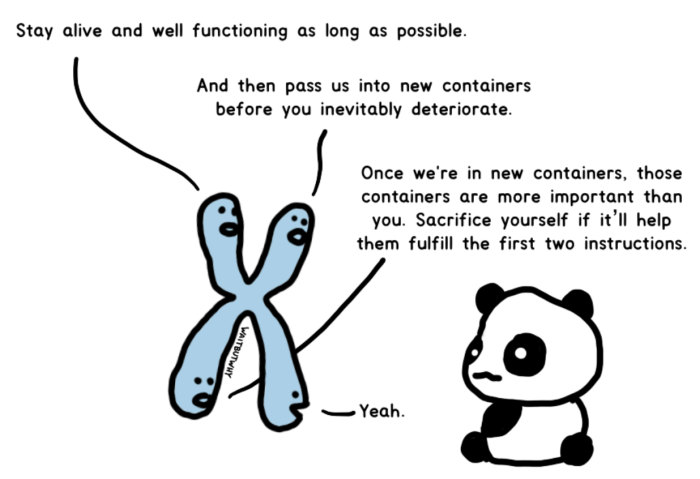
However they can’t communicate with the animal, “so instead they control them by having them run on specialized survival software.”
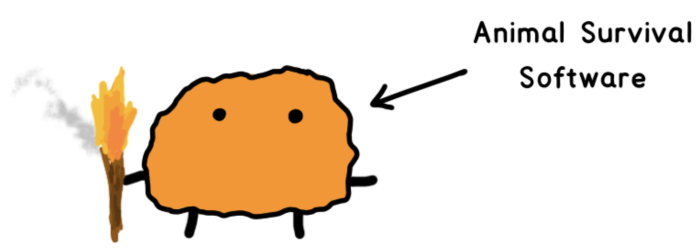
The animal software uses a series of behaviour-manipulation tools to control the behaviour of the animal.
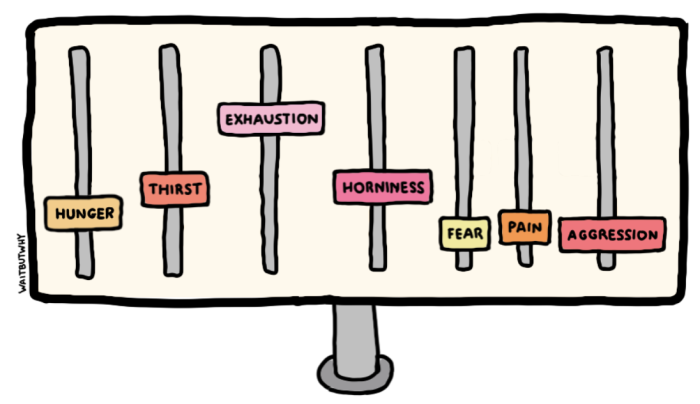
“By sliding the animal’s feelings up and down, an animal’s software uses the feelings like reins to keep the animal’s goals and the genes’ goals perfectly aligned.”
However, a few million years ago, the great apes decided to give super-high intelligence a go. It consumed way too much energy but they did it anyways.
With that came reason. With reason came the power to imagine. And with reason and imagination combined, we got empathy.

They ended up with two minds. The Primitive Mind (animal software) and the Higher Mind (independent new consciousness).
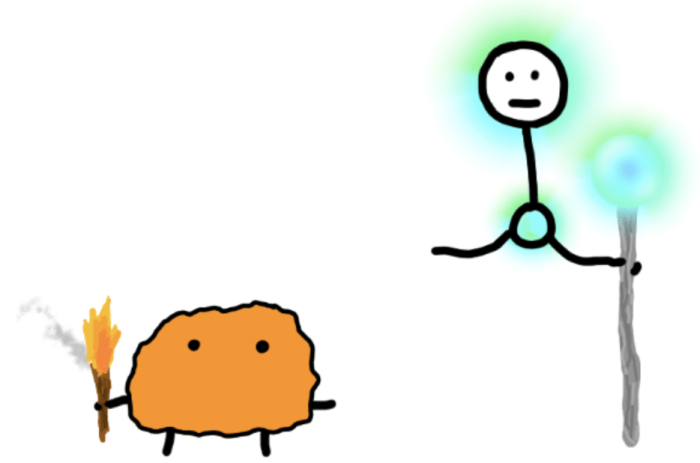
“The never-ending struggle between these two minds is the human condition. It’s the backdrop of everything that has ever happened in the human world, and everything that happens today. It’s the story of our times because it’s the story of all human times.”
The Human Giant
Billions of years ago single cells came together to form organisms.

It resulted in a loss of individuality but there were many advantages, so it stuck.
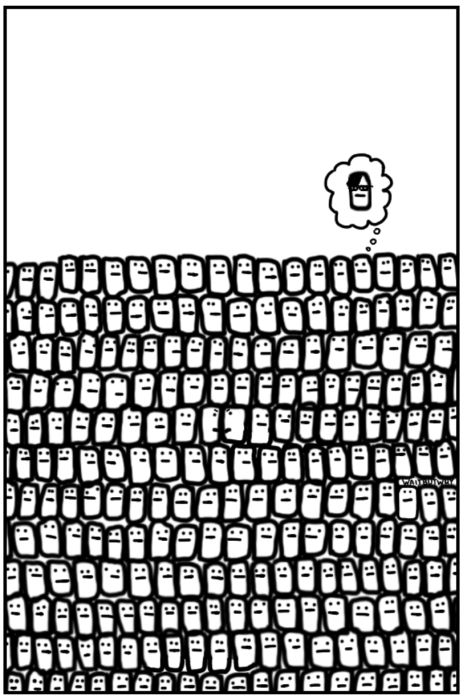
“A single cell is itself a giant—a magical living giant made up of trillions of non-living atoms—and an animal is a higher-level giant made up of trillions of cells. This concept—a bunch of smaller things joining together to form a giant that can function as more than the sum of its parts—is called emergence. We can visualize it as a tower.”
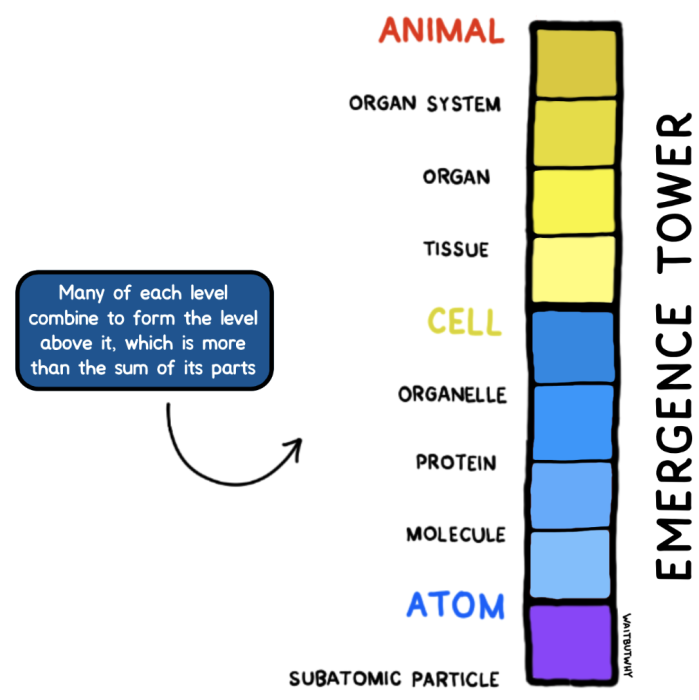
Animals form an even higher level giant by joining together, such as a school of fish, colonies of ants or a packs of wolves. The giant that humans form is known as the tribe.
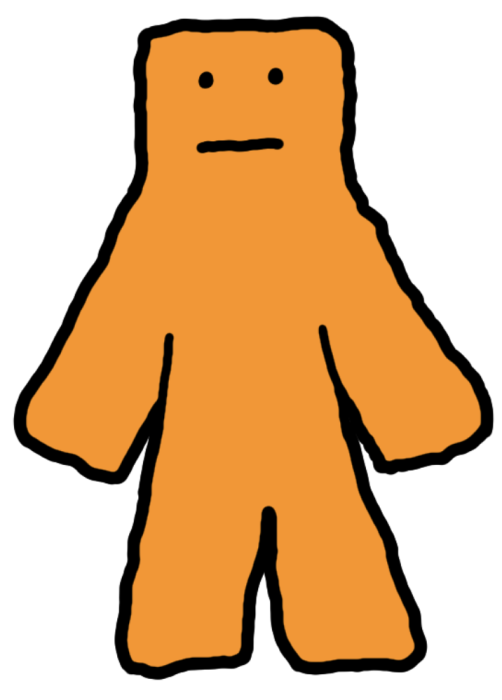
“When most of us consider what constitutes a complete life form and what doesn’t, it usually comes down to independence. We think of the sponge as a life form, but we think of each of its cells as mere parts of a life form.” But remove an ant from its colony and it won’t survive. “Because each of us is an animal…we’re biased to think of the animal as the key level along Emergence Tower—the point where the primary life form always exists”
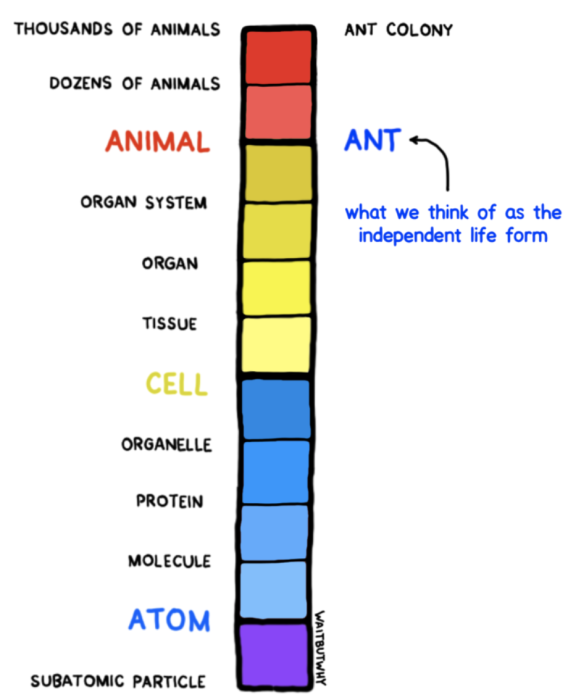
“If we’re not being animal-centric, though, we should probably put an ant in the same category as a sponge cell, and the ant colony in the same category as the sponge.”

In the world that we were designed for, it was the human tribe that was the independent life form not the human individual
So…
To understand human nature, we need to understand the tribe.
That’s how we can learn why we are the way we are. “For the human genetic line, sustenance was a survival requirement, so we evolved to be hungry. Reproduction was a survival requirement, so we evolved to be horny. Not falling off a cliff was a survival requirement, so we evolved to be scared of heights. Tribe well-being was a survival requirement, so we evolved to be tribal.”
Conflict
When humans are scared, they form giants.
The bigger the threat, the bigger the giant they form.















Once the threat disappears, tribalism melts away and the individuals go back down the emergence tower.
Stories
Humans are more than just ants in a colony competing with other colonies, they are also competing individuals. The glue between individuals in a tribe is weaker than the glue between the ants in a colony.
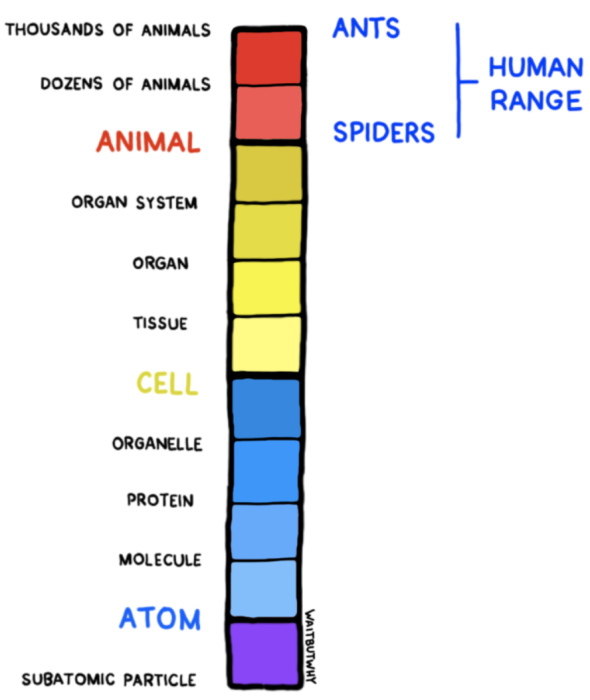
The bigger the size of the tribe, the weaker the glue. So historically the size of a tribe has been limited to approximately 150 individuals. So how is it that we find ourselves living in multi-million person cities? Historically humans couldn’t cooperate in thousands like bees can because a women can’t give birth to a thousand babies.
The way humans have become human beehives is through stories. “At some point between 150-person ancient tribes and New York City, human evolution jumped off of the survival of the fittest biology snail and onto the survival of the fittest stories rocket.”
Stories are like a virus. They need a host to live. And they need to spread to survive.
The story also needs to drive the behaviour of its host so it needs:
- Incentives (eg: heaven and hell)
- Accountability (you are being watched)
- Comprehensiveness (needs to have an answer for everything)
“If natural selection was calling for bigger, stronger, meaner giants, then the stories that enhanced that trajectory would be the fittest of them all. Our biological evolution made us tribal to help glue us together. The right story would be our superglue.”
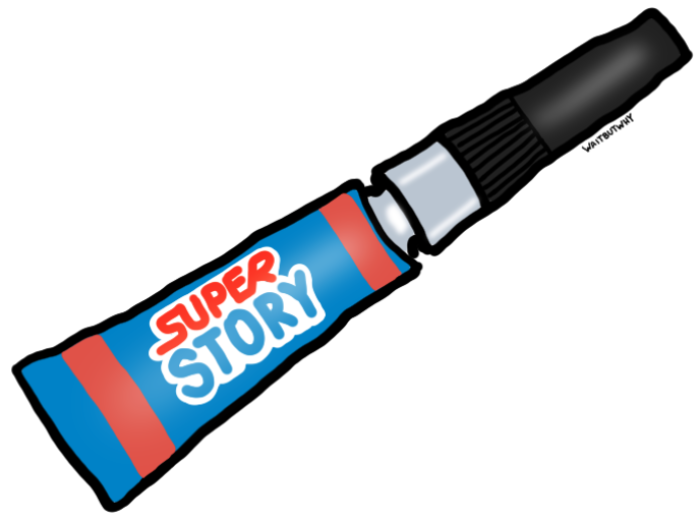
Ingredients to make human superglue:
- Tribal Values
- A Queen Bee
- Identity Attachment
- A Cudgel
Tribal Values
“A superglue story jacks up the Us > Them values. The story needs to be all about good guys and bad guys, with a crisp, clear distinction between the two. Strife between the good guys and bad guys is always the fault of the bad guys.” They are the enemy and “the bigger the common enemy, the stronger the glue.”
“On the Us > Them front, there’s an obstacle the story must contend with—the nuisance Higher Mind and all of his irritating disapproval of plundering and raping and beheading people. Because of the Higher Mind, it’s hard for people to truly hate a real human. It’s hard to pillage a settlement where real humans live. It’s hard to commit heinous violence against a real human. But is it hard to do awful things to filthy vermin and vile cockroaches and revolting scum of the Earth and agents of the underworld? Not really. An effective superglue story goes further than painting the enemy as bad, dangerous people—it dehumanizes them. Optimized geopolitical stories would turn everyday people into mass murderers by framing a soldier’s work as the noblest human calling.”
A Queen Bee
“If you want people to act like ants or bees, give them a queen.” The queen is rightful and mighty, and sacred. “Tribes split when they get too big for everyone in the tribe to have an intimate relationship with everybody else—but there’s no limit to the number of people who can have their own intimate relationship with the queen bee.”
“The human Primitive Mind comes hardwired with a full range of possibilities for rewards and penalties:”

Superglue stories extend the range significantly.
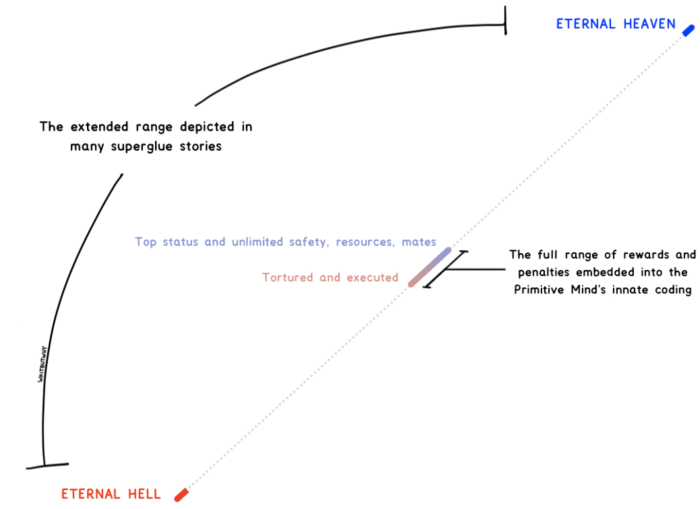
From this perspective, ordinary rewards and penalties seem trivial. “If you have to do some seemingly awful things in order to win a ticket to eternal heaven, you do them without a second thought.”
Identity Attachment
“When people see a story as an external object, then someone challenging the story is just making an intellectual argument. But when believers identify with a story, someone challenging the story is a personal threat. And since our brains are notoriously bad at distinguishing between our psychological identity and our physical body, the personal threat doesn’t feel like an insult—it feels like danger.”
“When a story becomes sacred to a group of people, you’ll hear lots of people spending lots of time talking about how true the story is—how great the story’s god is, how superior the story’s values are, or most commonly, how disgusting and vile the story’s bad guys are. Today we call it virtue signaling. It’s a common tribal practice, because doing this:”

Is really doing this:

Which is really doing this:

Which is really just this:

Which others will respond to by saying:

Which sounds to the person like:

A Cudgel
A common theme across human history is “humans bullying other humans”, if you had the power to do something, you could do it and get away with it. “This is because bullying is one of the primary ways the Primitive Mind does business. Bullying is just humans doing business in a primitive format: the Power Games.”
“Humans have power in numbers. That’s why tribe glue was so important in the ancient world. More glue = bigger tribe = bigger cudgel. And in the Power Games, a bigger cudgel is the means to every important end: safety, resources, mates, peace of mind.”
“You can’t build a tight beehive around a tolerant story—and even if you could, when the Power Games are all around you, it’s only a matter of time before tolerance is trampled over by intolerance.”
“In a Power Games environment, humans with a natural pull toward tribalism and conformity, with strong imaginations and questionable reasoning, and with an instinct to please powerful people rather than defy them, may have been the best survivors. It would explain a lot about the world around us today.” This is how brainwashing became the best cudgel. “If you could brainwash, you could play god.”
“Over hundreds of centuries, hyper-optimized superglue stories came to cover all the bases so thoroughly, they were able to do something biological evolution never could—convince masses of human beings to cooperate.”
And this is how we were able to push past the limit on tribe size and have millions of people cooperating in a country.
The next few chapters in the series cover the founding of America, the media, and the different ways of thinking. If you’d like me to summarise the next parts please let me know on Twitter, I’d love to hear from you.